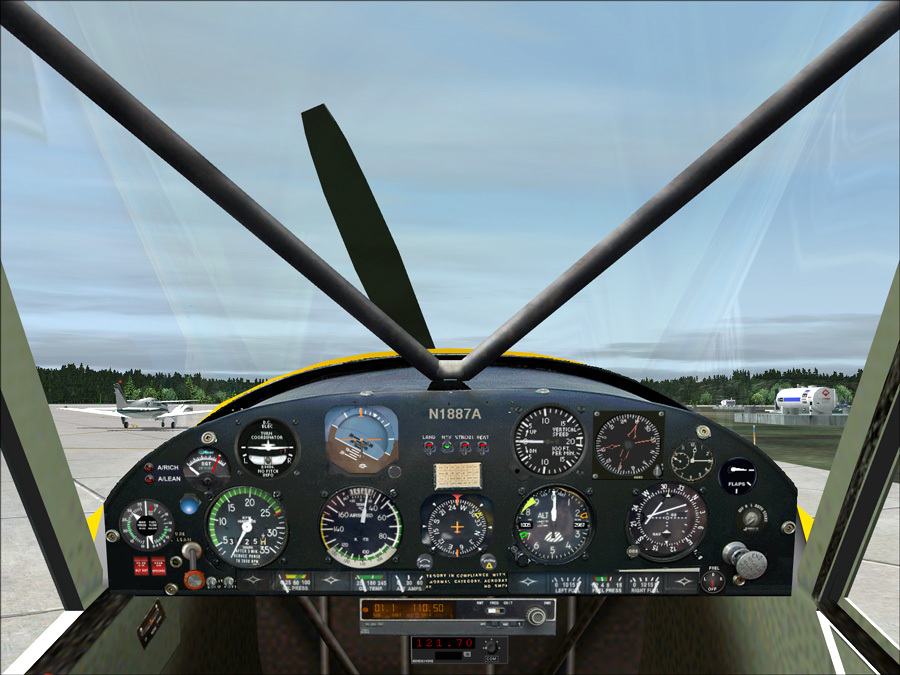I'm not sure that I have any other FS aircraft that demonstrate this correct "Spiral Instability" :think:...mind you, it did have one full tank and the other empty
Expert help on fuel usage requested...
Moderators: Guru's, The Ministry
- petermcleland
- Red Arrows

- Posts: 5201
- Joined: 25 Jul 2004, 10:28
- Location: Dartmouth, Devon
- Contact:
Re: Expert help on fuel usage requested...
BTW Chris...After entering the cockpit on noticing the stationary propeller after a "tea break"...I popped outside in spot view to just watch what happened...I was interested in the stability aspects and made no attempt to land anywhere. What really pleased me was the totally realistic "Spiral Instability", that all real aircraft have, showed up here to perfection with an ever steepening spiral with airspeed increasing to overspeed before hitting the lake nearly vertically.
I'm not sure that I have any other FS aircraft that demonstrate this correct "Spiral Instability" :think:...mind you, it did have one full tank and the other empty
I'm not sure that I have any other FS aircraft that demonstrate this correct "Spiral Instability" :think:...mind you, it did have one full tank and the other empty
Regards,

http://www.petermcleland.com/
Updated 28/8/2007
My Channel
http://www.youtube.com/user/petermcleland?feature=mhee

http://www.petermcleland.com/
Updated 28/8/2007
My Channel
http://www.youtube.com/user/petermcleland?feature=mhee
Re: Expert help on fuel usage requested...
Peter
When I did my ( Civil ) Instructor Rating in the 70s the standardised procedure for forced landings was to turn downwind , pick a field and then plan a conventional circuit to it . It came as something of a surprise when we began to be assessed by RAF Instructors for the Flying Scholarship courses for which we took about 8 cadets at a time, that the RAF procedure was quite different, involving effectively turning in a continuous rate 1 turn until one spotted a suitable field upwind from one's present position, when one rolled out onto finals. I suppose it worked quite well as long as one found a convenient field before reaching 500 feet agl , but I always felt that it was a slightly unplanned way of doing it , depending for success on the opportunistic selection of a field at a much later stage than the conventional ( for me but not the RAF!) method
Chris
When I did my ( Civil ) Instructor Rating in the 70s the standardised procedure for forced landings was to turn downwind , pick a field and then plan a conventional circuit to it . It came as something of a surprise when we began to be assessed by RAF Instructors for the Flying Scholarship courses for which we took about 8 cadets at a time, that the RAF procedure was quite different, involving effectively turning in a continuous rate 1 turn until one spotted a suitable field upwind from one's present position, when one rolled out onto finals. I suppose it worked quite well as long as one found a convenient field before reaching 500 feet agl , but I always felt that it was a slightly unplanned way of doing it , depending for success on the opportunistic selection of a field at a much later stage than the conventional ( for me but not the RAF!) method
Chris
- petermcleland
- Red Arrows

- Posts: 5201
- Joined: 25 Jul 2004, 10:28
- Location: Dartmouth, Devon
- Contact:
Re: Expert help on fuel usage requested...
That's how I was taught in 1951/2 Chris...Different though with a jet fighter...on a flameout you would get a radar vector to the nearest suitable airfield and then turn off your radio to preserve electrical power while gliding in that direction. On ETA or visual with the airfield you would circle. When passing the highest altitude permitted for relight, you would relight if possible...If failed then try for an 8000 feet Key Position high downwind and juggle it from there with flaps (and gear if it was a runway and you were sure you could make it)...If not a runway then leave the gear up or eject.cstorey wrote:Peter
When I did my ( Civil ) Instructor Rating in the 70s the standardised procedure for forced landings was to turn downwind , pick a field and then plan a conventional circuit to it .
I did all the first part of this once with a vector to Jever...It was overcast and I was orbiting on ETA and still above 8/8ths cloud. Then I successfully relit and turned my radio back on...to discover the Centre in a panic and trying to call me with details of the Jever weather (8/8ths at 500 feet!)...Anyway, panic over with the engine now running I just returned to base (Fassberg) :flying:
Regards,

http://www.petermcleland.com/
Updated 28/8/2007
My Channel
http://www.youtube.com/user/petermcleland?feature=mhee

http://www.petermcleland.com/
Updated 28/8/2007
My Channel
http://www.youtube.com/user/petermcleland?feature=mhee
- petermcleland
- Red Arrows

- Posts: 5201
- Joined: 25 Jul 2004, 10:28
- Location: Dartmouth, Devon
- Contact:
Re: Expert help on fuel usage requested...
Back to this little aeroplane that we have been working on...
Bandit Enterprises have finished their work on the Super Cub now and here are the pictures of the finished aircraft:-

This is the VC which shows all the instrument changes except the Fuel Status Gauge which is only on the 2D panel. The lighting of the VC panel has also been considerably brightened and now looks as bright as the...
The other shots can be seen by clicking this address:-
http://forum.fsscreenshots.com/dcboard. ... =full&page
Thanks for looking :flying:
Bandit Enterprises have finished their work on the Super Cub now and here are the pictures of the finished aircraft:-

This is the VC which shows all the instrument changes except the Fuel Status Gauge which is only on the 2D panel. The lighting of the VC panel has also been considerably brightened and now looks as bright as the...
The other shots can be seen by clicking this address:-
http://forum.fsscreenshots.com/dcboard. ... =full&page
Thanks for looking :flying:
Regards,

http://www.petermcleland.com/
Updated 28/8/2007
My Channel
http://www.youtube.com/user/petermcleland?feature=mhee

http://www.petermcleland.com/
Updated 28/8/2007
My Channel
http://www.youtube.com/user/petermcleland?feature=mhee
